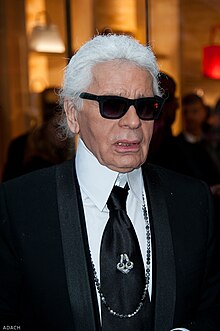Karl Lagerfeld References | Other websites | Navigation menuKarl Lagerfeld dead aged 85 - Chanel designer dies after weeks of ill healthKarl Lagerfeld Official WebsiteKarl Lagerfeld - BiographyMiami Beach USASundance Channel's Signé Chanel siteIn The Now. Where Karl Lagerfeld Lives"Interactive timeline of couture houses and couturier biographies"adding to it

Multi tool use
1933 births2019 deathsDeaths from pancreatic cancerCancer deaths in FranceGay menGerman LGBT peopleLGBT fashion designersPeople from Hamburg
HamburgGermanyParisfashion designerfashionChanelChloéFendiperfumesartistspancreatic cancer
Karl Lagerfeld
Jump to navigation
Jump to search

Karl Lagerfeld in 2014
Karl Lagerfeld (born Karl Otto Lagerfeldt; 10 September 1933 in Hamburg, Germany – 19 February 2019 in Paris ) was a fashion designer.
Many people saw him as one of the most influential persons of the late 20th century. He made fashion for many different labels, for example Chanel, Chloé and Fendi. He also owned several labels, which he started in the early 1980s. He also owned labels making perfumes. He designed clothes for many leading artists.
Lagerfeld died on 19 February 2019 from pancreatic cancer in Paris at the age of 85.[1]
References |
↑ Karl Lagerfeld dead aged 85 - Chanel designer dies after weeks of ill health
Other websites |
| Wikiquote has a collection of quotations related to: Karl Lagerfeld |
- Karl Lagerfeld Official Website
- Karl Lagerfeld - Biography
Miami Beach USA Article with photos on Karl Lagerfeld and his designs.- Sundance Channel's Signé Chanel site
New Yorker: John Colapinto: In The Now. Where Karl Lagerfeld Lives Extensive profile (ca. 10 000 words)
"Interactive timeline of couture houses and couturier biographies". Victoria and Albert Museum..mw-parser-output cite.citationfont-style:inherit.mw-parser-output .citation qquotes:"""""""'""'".mw-parser-output .citation .cs1-lock-free abackground:url("//upload.wikimedia.org/wikipedia/commons/thumb/6/65/Lock-green.svg/9px-Lock-green.svg.png")no-repeat;background-position:right .1em center.mw-parser-output .citation .cs1-lock-limited a,.mw-parser-output .citation .cs1-lock-registration abackground:url("//upload.wikimedia.org/wikipedia/commons/thumb/d/d6/Lock-gray-alt-2.svg/9px-Lock-gray-alt-2.svg.png")no-repeat;background-position:right .1em center.mw-parser-output .citation .cs1-lock-subscription abackground:url("//upload.wikimedia.org/wikipedia/commons/thumb/a/aa/Lock-red-alt-2.svg/9px-Lock-red-alt-2.svg.png")no-repeat;background-position:right .1em center.mw-parser-output .cs1-subscription,.mw-parser-output .cs1-registrationcolor:#555.mw-parser-output .cs1-subscription span,.mw-parser-output .cs1-registration spanborder-bottom:1px dotted;cursor:help.mw-parser-output .cs1-ws-icon abackground:url("//upload.wikimedia.org/wikipedia/commons/thumb/4/4c/Wikisource-logo.svg/12px-Wikisource-logo.svg.png")no-repeat;background-position:right .1em center.mw-parser-output code.cs1-codecolor:inherit;background:inherit;border:inherit;padding:inherit.mw-parser-output .cs1-hidden-errordisplay:none;font-size:100%.mw-parser-output .cs1-visible-errorfont-size:100%.mw-parser-output .cs1-maintdisplay:none;color:#33aa33;margin-left:0.3em.mw-parser-output .cs1-subscription,.mw-parser-output .cs1-registration,.mw-parser-output .cs1-formatfont-size:95%.mw-parser-output .cs1-kern-left,.mw-parser-output .cs1-kern-wl-leftpadding-left:0.2em.mw-parser-output .cs1-kern-right,.mw-parser-output .cs1-kern-wl-rightpadding-right:0.2em
Categories:
- 1933 births
- 2019 deaths
- Deaths from pancreatic cancer
- Cancer deaths in France
- Gay men
- German LGBT people
- LGBT fashion designers
- People from Hamburg
(window.RLQ=window.RLQ||[]).push(function()mw.config.set("wgPageParseReport":"limitreport":"cputime":"0.124","walltime":"0.169","ppvisitednodes":"value":199,"limit":1000000,"ppgeneratednodes":"value":0,"limit":1500000,"postexpandincludesize":"value":4095,"limit":2097152,"templateargumentsize":"value":345,"limit":2097152,"expansiondepth":"value":13,"limit":40,"expensivefunctioncount":"value":0,"limit":500,"unstrip-depth":"value":0,"limit":20,"unstrip-size":"value":2326,"limit":5000000,"entityaccesscount":"value":0,"limit":400,"timingprofile":["100.00% 137.969 1 -total"," 67.39% 92.975 1 Template:Cite_web"," 26.29% 36.273 1 Template:Wikiquote-en"," 22.85% 31.523 1 Template:Sister"," 20.17% 27.835 1 Template:Side_box"," 6.65% 9.172 1 Template:Sec_link_auto"," 6.21% 8.564 1 Template:Bio-stub"," 2.59% 3.580 1 Template:Stub-template"," 1.81% 2.494 1 Template:Sec_link/text"," 1.77% 2.442 1 Template:Sec_link/normal_link"],"scribunto":"limitreport-timeusage":"value":"0.068","limit":"10.000","limitreport-memusage":"value":1326802,"limit":52428800,"cachereport":"origin":"mw1257","timestamp":"20190409122555","ttl":2592000,"transientcontent":false);mw.config.set("wgBackendResponseTime":91,"wgHostname":"mw1246"););Y6Y wzrTw b1jQT9HCOlm,LNkzGe69NYuLa3Vbw25KGAK2Yj6RL9k2zVwmL63 1GivS1C33jGJ10gLTj ULho07EnME5